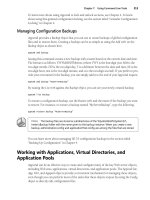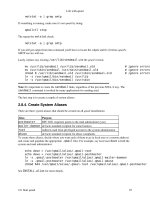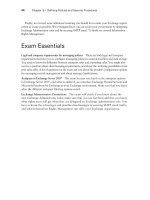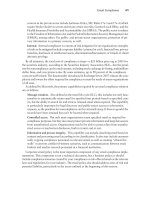modeling structured finance cash flows with microsoft excel a step by step guide phần 4 potx
Bạn đang xem bản rút gọn của tài liệu. Xem và tải ngay bản đầy đủ của tài liệu tại đây (932.33 KB, 22 trang )
Prepayments
47
FIGURE 3.2 A standard analysis of prepayment rates is completed by tracking each
origination period separately over time.
1. That the assets requiring prepayment projections are the same as the assets used
to create the projected prepayment curve. This might sound like simple logic,
but if the asset class is for example mortgages and the historical prepayment
data is generated off of fixed rate mortgages, the prepayment curve calculated
should only be used for fixed rate mortgages from that company. This distinction
should even be as granular as the precise type of mortgage, since prepayment
rates for mortgages are very particular to the type of product.
2. That there is no significant trend in the prepayment rates. If a noticeable
increasing or decreasing trend is apparent in the historical prepayment rates
and this trend is expected to maintain, it should be accounted for in the
projected curve. Sometimes a shift in market focus, origination process, or
economic environment causes such a trend, which could affect future prepayment
performance.
3. While more complex than this text will demonstrate in the examples, a consid-
eration for any prepayment curve should be interest rates. Prepayment behavior
is closely linked to interest rates. A simple example is a homeowner with a mort-
gage, which could be fixed or floating. If the mortgage is fixed rate and it was
originated during a high interest rate environment, the homeowner will be more
inclined to refinance when interest rates decline. Or, if a floating rate mortgage
was originated during a low interest rate environment, the obligor would want
to refinance to a fixed rate if he or she expects interest rates to increase. In more
advanced prepayment analyses, expected interest rate scenarios should be run
using a variety of prepayment curves.
PREPAYMENT CURVES IN PROJECT MODEL BUILDER
Once the projected curve is created it will be stored in the model. For maximum
flexibility the model should have room for multiple custom curves, conversion
48 MODELING STRUCTURED FINANCE CASH FLOWS WITH MICROSOFT EXCEL
formulas for the main types of prepayment rates (as described above), and standard
prepayment curves. Also, the model should be developed in a way that it is easy
to select which curve to use, the option to use different curves for specific groups
of assets, and a method of automating scenarios so curves can be selected and run
without much adjustment. All of this will be demonstrated and worked through in
the Model Builder exercises.
THE EFFECT OF PREPAYMENTS ON STRUCTURED TRANSACTIONS
Prior to the step-by-step exercises in the Model Builder sections a moment should
be taken to understand the effects that prepayments have in a structured finance
transaction. Prepayments accelerate the repayment of principal for the assets and,
in pass-through structures, the principal of the notes or certificates. At first thought
an investor might think prepayments are good since they will have their principal
returned to them faster.
This is true if the assets are consistently performing poorly and there is risk that
there will not be enough cash flow to repay the investor. In such a case, one would
want their money as fast as possible. However, when assets are performing as they
are expected, there should be more asset interest than liability cost—also known
as excess spread. This excess spread provides credit protection over the life of a
transaction. Obligors who tend to prepay the fastest are the better credits with high
interest rates that, when, eliminated, reduce excess spread. If those higher interest
obligors prepay quickly, the transaction terminates faster and overall there will be less
excess spread in the deal than if the assets prepaid at a slower rate. This is extremely
important because if a comparison were made between two transactions—A and
B—where everything was the same including default rate but the only difference
was transaction A prepaid faster than transaction B, then transaction A would have
less excess spread.
Another consideration is that the prepaymentrate needs to be modeled accurately
to give a correct estimation of the weighted average life of the transaction and the
total return provided to investors. Institutional investors often purchase asset-backed
securities with certain tenors and returns in mind. Prepayments can drastically affect
the weighted average life of a transaction and can reduce the overall interest paid,
thereby reducing the total return of investment.
MODEL BUILDER 3.1: HISTORICAL PREPAYMENT ANALYSIS AND
CREATING A PROJECTED PREPAYMENT CURVE
1. The first step in any prepayment analysis is to review the data that exists. Open
MB3-1
Raw Data.xls from the Ch03 folder on the CD-ROM. There is only
one sheet in this workbook and it contains very pertinent and organized data for
Prepayments
49
a prepayment analysis. The data included on the sheet is the minimum amount
necessary to complete a prepayment analysis: pool balances and prepayment
amounts.
2. To get started with the analysis, create another sheet and name it Prepay
Analysis. This sheet is where the SMM prepayment rates will be calculated and
aggregated by pool. Since the data will be organized similar to the raw data,
copy cells A5:AA31 from the Raw Data sheet and paste them on A5 of the
Prepay Analysis sheet.
3. Clear the contents of cells A7:AA7 because there will be no prepay rates in
time 0. The formula to calculate the SMM rates is the prepay amount for
the current period divided by the beginning of period balance. In the official
formula, scheduled principal should be deducted from the beginning of period
balance; however, in this case there is no information on how the balance is
reduced each month (that is, what portion is scheduled principal versus default).
The difference should not have a significant impact so using the beginning of
period balance is sufficient. The Excel formula to enter in cell C8 is:
='Raw Data'!C39/'Raw Data'!C7
4. When this is copied from C8:AA31, there is a minor problem with #DIV/0
errors. This can be easily taken care of with an IF statement. Modify cell C8 as
follows:
=IF('Raw Data'!C39="","",'Raw Data'!C39/'Raw Data'!C7)
This will prevent any 0 balances from trying to calculate and stop division by
zero errors from populating across the sheet. At this point, the analysis should
look like an upside down triangle as pictured in Figure 3.3.
5. With each vintage’s prepayment rates laid out over time, the next step is to
create an aggregate curve that represents how the asset’s prepay on average.
Since the vintages have different balances a weighted average should be used for
the rates. The easiest way to calculate a weighted average in Excel is using a
SUMPRODUCT-SUM combination. If this has never been done before, there is
a detailed explanation in the Toolbox section of this chapter. There is a slight
difference when using this combination for curves because there could be zero
values that could skew the average. To eliminate this potential problem, a count
of relevant cells needs to be created.
6. Label cell AC6 WA Count. The cells in AC8 through AC31 will contain a
numeric value that represents the relevant number of cells of data for each
period that should be calculated in the weighted average. For example, row 8
contains data for the first period of each vintage, row 9 the data for the second
vintage, and so on. Notice though that the data is a triangle and the further the
periods out, the less data exists. This is logical because if the current month is
the beginning of January 2006 there should be no data for January 2006 one
month out nor two months of data for loans originated in December 2005. To
50 MODELING STRUCTURED FINANCE CASH FLOWS WITH MICROSOFT EXCEL
FIGURE 3.3 The raw prepayment data should be converted into percents and cleaned
up at this point.
help with the SUMPRODUCT-SUM combination a numeric count of the data
that should be included in the calculation is necessary. This can be accomplished
by using the COUNT formula in conjunction with data specific modifications.
7. In cell AC7, use COUNT on the cells C6 through AA6. This produces a value
of 25. Lock this reference down. For the first period in cell AC7, there is one
period of unknown data: January 2006. In the next period there will be two
periods of unknown data: January 2006 and December 2005. To use a single
formula to not count those months, subtract the current period from the count.
Since the numeric periods exist in column B, use those as the reference. The final
formula should look like:
=COUNT($C$6:$AA$6)−B8
Copy and paste this formula into cells AC8 to AC31. The result should be
a vertical row of numbers that decrease as the periods decrease as shown in
Figure 3.4.
8. Next label AD6 WA SMM Curve. This is where the weighted averages (WA)
are calculated. Any weighted average of A data is the sum of the products of
A data and B data divided by the sum of B data. This can be accomplished in
Excel using SUMPRODUCT and SUM. An additional element of complexity is
making sure not to average blank cells. This is done using the OFFSET function
within the other formulas. In cell AD8 enter the following formula:
= SUMPRODUCT(C8:OFFSET($B8,0,$AC8),'Raw Data'!C7:OFFSET
('Raw Data'!B7,0,$AC8))/SUM('Raw Data'!C7:OFFSET('Raw
Data'!B7,0,$AC8))
Prepayments
51
FIGURE 3.4 Notice the count function and the
WA SMM Curve.
The SUMPRODUCT is taking two rows of data: the monthly SMMs (row 8
of the Prepay Analysis sheet) and the beginning of period balances for each
vintage (row 7 of the Raw Data sheet). Instead of taking the entire row of data
though, the SUMPRODUCT reference uses an OFFSET function to instruct
the SUMPRODUCT to only take a certain amount of cells. This OFFSET
uses the count system of relevant data created in column AC. This way the
SUMPRODUCT only references the relevant data. Similarly, the SUM of the
balances that is used as the divisor only takes in the relevant balances. If this
OFFSET didn’t exist the SUM would be much higher than necessary. Copy and
paste the formula into cells AD8:AD31.
9. Create an additional sheet and name it Summary. This is where the curves that
will be used for the projected modeling will be stored. Copy cells A7:B31 from
the Prepay Analysis sheet and paste them in A7 of the Summary sheet. On the
Summary sheet, label D5 WA SMM Curve. In D8 through D31, reference the
52 MODELING STRUCTURED FINANCE CASH FLOWS WITH MICROSOFT EXCEL
WA SMM curve from the Prepay Analysis sheet. Typically this is what will be
used in a model to forecast prepayments. It has been simplified with only two
years of data to keep the example simple, but in models like Project Model
Builder a longer curve or estimation is typically necessary. This can be achieved
by using more data, using a standard curve like PSA, or using rating agency
assumptions that are often given in terms of CPR.
10. To see how SMM translates into CPR and vice versa, label cell E5 CPR. In cell
E8, use the following formula to convert to CPR:
=1−(1−D8) ˆ 12
Copy and paste this formula over the range E8:E31. These are the annualized
rates of the SMMs. Rating agencies often give CPR assumptions for assets, so it
is important to understand how to go back and forth between calculations. The
final prepayment curve should look like Figure 3.5.
FIGURE 3.5 The final prepayment curve is expressed
in SMM and CPR.
Prepayments
53
MODEL BUILDER 3.2: INTEGRATING PROJECTED PREPAYMENTS IN
ASSET AMORTIZATION
1. The last part that was completed in Project Model Builder was the creation of a
notional amortization schedule. This Model Builder section will begin creating
the actual amortization schedule beginning with prepayments. Go to the Cash
Flow sheet in Project Model Builder and label cell L3 Actual Amortization.
Below this, in row 4, is a series of column headers. Label the following cells as
described:
L4: Beginning Balance
M4: Default Rate
N4: New Defaults
O4: Amort Factor
P4: Prepay Rate
Q4: Voluntary Prepay
R4: Actual Amort
S4: Interest Rate
T4: Actual Interest
U4: Principal Recovery
V4: Ending Balance
Many of these columns are placeholders for chapters to come; but they should
be created now rather than inserting columns later.
2. Two of these columns contain formulas in period 0 (row 6): the Amort Factor
and the Ending Balance, which as mentioned earlier is the starting balance when
it is in time period 0. The Amort Factor is the ratio of the current notional
balance to the original notional balance. This is important because it is an
indication of how the asset balance is reduced on a scheduled basis and will be
used to help determine prepay amounts. In period 0, however, it is always 1 since
no amortization has taken place. Otherwise it is the end of period scheduled
balance over the original scheduled balance. This is the formula that should be
entered in O6 and copied and pasted through O366:
=IF(A6=0,1,J6/$J$6)
The Ending Balance will always be the starting asset current balance for period
0, but will reduce by scheduled amortization, prepayments, and defaults. Even
though the cells are empty right now use the following references in the formula
for cell V6:
=IF(A6=0,AssetCurBal1,L6−N6−Q6−R6)
Copy and paste this formula into the range V6:V366.
3. The next column to work on is column L, the Beginning Balance. As in the
notional schedule, the beginning balance will always be the ending balance from
54 MODELING STRUCTURED FINANCE CASH FLOWS WITH MICROSOFT EXCEL
the period prior. In cell L7, enter the reference =V6and copy and paste it down
through the range L6:L366.
4. Before proceeding to the Prepay Rate, the Inputs sheet needs to be updated so
Prepayment Inputs can be changed quickly. On the Inputs sheet, merge cells
B16:O16 and use the long cellas a label that states PREPAYMENT/DEFAULTS/
RECOVERY INPUTS. Also add the following labels:
B17: Description
C17: Prepay Curve
D17: Prepay Stress
5. The Description is a reference to the description of the assets that the pre-
payment, default, and recovery information will affect. This is Asset Pool
1, which was named AssetDes1. In B18, enter =AssetDes1. Name this cell
pdrDes1.
6. C18 is where the prepayment curve will be selected from the Vectors sheet. This
is very similar to the asset interest rate curve selection. Like that one there needs
to be a selection of possible curves on the Vectors sheet. Go to the Vectors sheet
and enter the following labels into these cells:
M5: SMM 1
N5: SMM 2
O5: SMM 3
P5: Custom CPR 1 DATA ENTRY ONLY
Q5: Custom CPR 2 DATA ENTRY ONLY
R5: Custom CPR 3 DATA ENTRY ONLY
Select and name the range M5:O5 lstPrepayCurve.
7. Go back to the Inputs sheet and select C18. Using data validation, make the
possible inputs for this cell the range lstPrepayCurve. There should only be three
possible inputs because the range only included the SMM ranges. The CPR
columns created on the vector sheet, which are labeled DATA ENTRY ONLY,
are used to put CPR curves in, but must be converted to SMM for use in the
model. Name C18 pdrPrepay1.
8. D18 contains the stressor for prepayments. This is a numeric multiple that is
multiplied against the prepayment curve at each period. For now enter a 1 in
cell D18 and name the cell pdrPrepayStress1.
9. To follow in the example calculations, copy and paste the existing prepayment
curve, which is present in the completed section of the Vectors sheet in this
MB3-2.xls in the Ch03 folder on the CD-ROM. This curve should be pasted
in the same place, cells M7:M366. (In the Ch03 folder on the CD-ROM, there
is an example in the Additional Files subfolder that contains the PSA curve
calculation.)
10. The next step is having the correct prepayment rate show up on the Cash
Flow sheet. This is accomplished in a similar manner to the asset interest rate,
using an OFFSET-MATCH combination, but is much simpler since there are
no caps, floors, or rate resets. The numerical value that should show up in P7
depends on the prepay curve selected on the Inputs sheet and the period (in this
Prepayments
55
case 1). Since the values are stored on the Vectors sheet, the OFFSET will start
there with Vectors L5. To get the correct rate Vectors L5 needs to be offset
by the period that the formula is in (1 in the case of Cash Flow P7) and the
prepay curve (the selected one in this example is SMM 1, which is the first
curve in the list). An additional factor that needs to be taken into consideration
is the seasoning. Seasoned assets need to reference their correct timing on the
prepayment curve, otherwise the wrong historically created prepayment percents
will be applied to the asset balances. The following formula will accomplish this
and change as different curves are selected on the input sheet and as the periods
change:
= OFFSET(Vectors!$L$6,A7+Age1,MATCH(pdrPrepay1,
lstPrepayCurve,0))*pdrPrepayStress1
Copy and paste this formula from P7 through P366.
11. The final formula of this Model Builder exercise is the most critical. It determines
the actual dollar amount of prepayments for the period. The first part of this
formula is an IF function for clean up purposes. If there is a zero balance and
the prepay calculation is attempted then there will be #DIV/0 errors. To prevent
this start the formula in Q7 with:
=IF(L7=0,0,
The next parts of the formula are MAX and MIN formulas. The MAX for-
mula ensures that in cases of high default there is no negative balance that
could skew prepayments. The MIN formula takes the lesser of the balance
less defaults and the calculated prepay amount. The balance less defaults is
the Beginning Balance minus New Defaults (L7–N7). The prepayment calcu-
lation is the Beginning Balance multiplied by the percentage asset reduction
in the notional schedule multiplied by the monthly prepayment rate (as mea-
sured in SMM). A confusing part of the last statement is what ‘‘the percentage
asset reduction in the notional schedule’’ is and why it is part of the cal-
culation. This is the current amort factor divided by the last month’s amort
factor. This represents the scheduled amortization on a fractional basis and
removes it from the prepayment amount. The final formula should look
like:
=IF(L7=0,0,MAX(MIN((L7−N7),L7*O7/O6*P7),0))
In particular, notice that defaults (N7) are removed from the Beginning Balance
as part of the MIN function. This is important because as loans approach
their final periods they will have to be cleaned up. Defaults take precedence
in calculations since it is assumed that a defaulted loan will not voluntarily
prepay.
56 MODELING STRUCTURED FINANCE CASH FLOWS WITH MICROSOFT EXCEL
TOOLBOX
Weighted Averages Using SUMPRODUCT and SUM
When doing any analysis in finance on a pool of assets the word ‘‘average’’ comes
up often: What is the average interest rate? How long is the average remaining term?
What is the average age of the loans? The answers to all of these questions must
be provided in terms of the weighted average, otherwise an incorrect estimation
will most likely be made. The reason for this is that financial assets that are pooled
together in a transaction rarely have homogenous principal balances from the start,
with differences being more exacerbated as time progresses.
Principal balances are important because in a pool of assets, those with larger
principal balances will have more influence on the characteristics and performance
of the pool than assets with smaller balances. An easy example is to take a look
at a pool of two loans, their balances, and their remaining terms. In the examples,
the loans are quite different. One is fairly new and has a high principal balance
and a long remaining term while the other is very seasoned and has a low principal
balance and short remaining term. As seen in Figure 3.6 (and in Ch03’s Additional
Files subfolder for the Model Builder files on the CD-ROM), the average remaining
term and rate of this pool is taken by using the AVERAGE function in Microsoft
Excel. This produces a result of 187.50 periods and a rate of 6.00 percent.
This is a misleading result because most of the pool’s money will be outstanding
for much longer than 187.50 periods and at a far higher rate than 6.00 percent. The
correct way to describe the average remaining term is to weight the average by the
current principal balance. By using a weighted average based on current balance,
the remaining term would be nearly 360 periods with a rate of 10 percent. This
is done by multiplying the terms by the balances, summing up those products, and
then dividing that sum by the sum of the principal. The weighted average can be
calculated without using functions, but the calculation is made much easier by using
SUMPRODUCT and SUM.
FIGURE 3.6 There is a noticeable difference between taking
an arithmetic average and a weighted average.
Prepayments
57
SUMPRODUCT takes two arrays of equal length and multiplies each value in
one array by the corresponding value of the second array, and then sums up all
of those products. In Figure 3.6, for example, the remaining term array (E4:E5)
is multiplied by the corresponding balances (C4:C5). SUMPRODUCT finishes by
calculating the sum of all of these products. The arrays should be referenced in this
manner:
=SUMPRODUCT(Array Reference 1, Array Reference 2)
SUMPRODUCT takes care of the first two parts of calculating a weighted
average, so all that is left is to divide by the sum of the balances using the SUM
function. This function combination can be used for calculating weighted averages
for any loan characteristic and typically uses the current principal balance as the
weighting.
Also, as seen in this chapter, the weighted average should be used for summariz-
ing historical rates. Often, for such purpose, the OFFSET function needs to be used
on the arrays to prevent zeros from skewing the average.
CHAPTER
4
Delinquency, Default, and
Loss Analysis
N
early every asset class in structured finance is subject to loan obligors not paying.
This eventually generates losses. While the concept of an obligor defaulting
and causing a loss is not difficult to understand, historical loss reporting, future
loss projection, and how a structured transaction model is constructed to handle
these are often a cause of confusion. Because there is no standardized method
for reporting, projecting, or modeling loss, data is often presented in inconsistent
and sometimes misleading formats. The most favored format of understanding
historical loss information is the static loss report, which tracks losses for each
origination period over time. This format is ideal for building historical loss curves
and producing a projected loss curve with severity and timing that is predicated on
prior asset performance.
Incorporating loss into a model can also be done a number of ways depending
on certain rating agency methodologies and subjective formula techniques. This
chapter lays the groundwork for understanding loss and shows one possible method
for integrating the concept into a functioning model. Later in this book there are
discussions about other methodologies.
DELINQUENCIES VERSUS DEFAULTS VERSUS LOSS
One reason understanding loss can be so confusing is the terminology that is involved
in the process leading up to a loss. To be clear prior to any use, the following related
terms are defined:
■
Delinquency. When a payment is due on a specific date and the obligor fails
to pay the payment by that date the obligor is delinquent. A more granular
analysis of delinquency typically splits delinquency into monthly intervals such
as 1 to 30 days delinquent, 31 to 60 days delinquent, 61 to 90 days delinquent,
and so on. A key point to an obligor being considered delinquent is that there is
an expectation of more payments and the possibility that the obligor will repay
enough to no longer be considered delinquent.
59
60 MODELING STRUCTURED FINANCE CASH FLOWS WITH MICROSOFT EXCEL
■
Default. Depending on company and legal definitions, a delinquency eventually
becomes a default. When obligors are considered defaulted, they are no longer
expected to make regular payments and legal action typically begins. It is very
important to realize that the timeframe it takes for an obligor to transition from
delinquency to default is usually set by legal definitions in structured transactions
and that loss expectations can change depending on the time it takes to classify
an obligor as a default.
■
Loss. When a loan is considered a default, some companies instantly write
the principal balance of the loan off. This is known as a gross loss.Astime
progresses, sometimes a recovery is made either through the sale of a repossessed
asset or continued pursuance of credit collection.
The well-known fixed income expert, Frank J. Fabozzi, stresses the importance
of terminology by defining a loss as follows:
A default is essentially a loan that does not get paid back. A loan may
go into the 90-day delinquent category or even into foreclosure, and still
be made current again. So only those loans that are ultimately liquidated
for non-payment are classified as defaulted loans. Losses refer to the dollar
amounts lost on defaulted loans.
1
A useful example is to examine one loan in a hypothetical loss situation. Imagine
a mortgage loan that had an original balance of $1,000.00, a current balance of
$586.50, is in its 20th month and stops paying. Figure 4.1 depicts the timeline of
events and classifications that the loan would go through.
As can be seen from Figure 4.1, the loan is considered delinquent until 90 days
have passed by and then it becomes classified as a default. In this case, it is written off
instantly and the legal process begins. After 14 months, a court orders a foreclosure.
The asset takes three months to sell and an asset recovery is realized.
THE IMPORTANCE OF ANALYZING DELINQUENCY
Understanding the asset pool’s tendency to initially stop paying on time is a logical
starting point for a loss analysis. This is done by examining historical delinquency
data on similar assets and is important for two reasons: credit trends and liquidity.
Credit trends are an indication of whether assets will perform better or worse and
whether a greater or lesser amount of loss should be expected in the future. Liquidity
is a transaction-specific consideration that refers to the amount of actual cash in any
given period.
1
Frank J. Fabozzi, Bond Credit Analysis: Framework and Case Studies (New Hope, PA: Frank
J. Fabozzi Associates, 2001), 245.
Delinquency, Default, and Loss Analysis
61
FIGURE 4.1 A timeline of the events that take place when an asset defaults.
The first concern, credit trends, is important because it could mean that a future
loss projection might have to be increased. Credit trends are noticeable when
a delinquency analysis is performed on existing assets. If, over the course of
origination, assets progressively have increased delinquency, the loss expectation
may be higher. Greater delinquency sometimes means that the company originating
the assets is chasing riskier assets, possibly for greater returns. In this case, the
obligors’ credit scores and interest rates should be examined more closely.
The second concern, liquidity, is extremely important in building a structure
that is sized and risk rated correctly. If assets consistently have a high delinquency,
this needs to be accounted for in a model; otherwise there might not be enough
cash to cover loss, principal, interest, and possibly fees. Delinquency directly affects
cash flow because a delinquent loan does not have any cash flow; but it is also not
considered a default. This means that its balance is not written down, excess spread
does not cover the loss, and no cash is received. After the liability side of the model
is complete, this concept becomes clearer.
Both concerns require the creation of historical delinquency curves. These curves
are useful in determining credit trends and the severity of delinquency. The curves
are not actually used in Project Model Builder, but they are created using a Model
Builder exercise since the analysis is very important.
62 MODELING STRUCTURED FINANCE CASH FLOWS WITH MICROSOFT EXCEL
MODEL BUILDER 4.1: BUILDING HISTORICAL DELINQUENCY CURVES
1. Ideally a historical delinquency analysis begins with data from assets similar to
those in the transaction. In this exercise, data has been provided in the Ch04
folder on the CD-ROM. Open the file MB4-1
Raw Data to access the raw
data. Save the file as Historical Delinquency Curves.xls.
2. There are two sections of data provided: The top section is the current balance of
loans, grouped by vintage, reported on a periods-out basis. The bottom section
contains the current balance of loans that are in the 30-day delinquency bucket
(that is, they have missed their payment date by 1 to 30 days). The best way to
understand the magnitude and trend of the delinquencies is to calculate them
on a percentage basis. First, to create an area for the rates, copy C37:AA37 and
paste this cell range in C66:AA66. Also copy B38:B62 and paste this cell range
in B67:B91. Labels for the axis of the ranges can also be copied down, but make
sure to leave row 65 blank for now.
3. The proper delinquency calculation is the current month’s delinquency over the
prior month’s ending balance. The formula for this is a simple division equation;
but it needs some cleaning up to prevent #DIV/0 errors. In cell C68 enter:
=IF(C39="","",C39/C7)
This formula cleans up zero-balance periods and divides the delinquency by the
current balance of the prior period.
4. To get a sense for all of the vintages, a weighted average is useful. As seen
in Chapter 3, calculating a weighted average is most simply done using a
SUMPRODUCT-SUM combination and is discussed in more detail in the
Toolbox section of that chapter. Also, to prevent picking up blank cells, an
OFFSET function is needed. Prior to creating the formula, the OFFSET needs a
reference value to determine how many cells of data each vintage contains. Since
January 2004 contains the maximum periods of data (24) and each successive
month has one less period of data, a column of decreasing values is necessary.
Starting in A68, enter 24, and then in B68 enter 23. Highlight both of these cells
and drag the decreasing value down to A91. The worksheet should look like
Figure 4.2 at this point.
5. Cell AC68 will contain the weighted average of the first period, AC69 the second
period, and so on. In cell AC68 enter:
=SUMPRODUCT(C68:OFFSET(B68,0,A68),C7:
OFFSET(B7,0,A68))/SUM(C7:OFFSET(B7,0,A68))
This weighted average formula multiplies each delinquency rate by the respective
vintage’s prior period current balance. This creates the weighting and then
divides the sum of those values by the sum of the balances to get the weighted
Delinquency, Default, and Loss Analysis
63
FIGURE 4.2 A standard set of delinquency curves organized by periods out.
FIGURE 4.3 Delinquency performance can be quickly
understood from a chart.
average rate. An OFFSET is used to make sure that no blank values are
picked up.
6. Charts are often seen to represent this data as seen in Figure 4.3.
The delinquency data in Model Builder 4.1 is useful because it shows the amount
that is delinquent 1 to 30 days. This is useful knowledge for later if a liquidity reserve
64 MODELING STRUCTURED FINANCE CASH FLOWS WITH MICROSOFT EXCEL
needs to be sized in the modeling. Also, notice that there is a slight trend in the
data. Earlier vintages have experienced slightly more delinquency than later vintages,
suggesting an improving trend in credit quality. This could possibly be an argument
for reducing loss projections.
Keep in mind that this is the most basic delinquency analysis that can be
completed. Often the process is repeated for each delinquency interval (i.e., 1 to
30 days, 31 to 60 days, and so on). Delinquency information can also be used to
create transition matrices, which can be used as a proxy for loss if there is a limited
amount of historical data. However, if there is static vintage data, historical loss
curves should be created and analyzed.
DERIVING HISTORICAL LOSS CURVES
Delinquencies that eventually pay only create liquidity issues and negative drag on
the transaction and are not as important as the loans that completely stop paying
and are considered defaults. Similar to delinquency, default expectations for a pool
of assets can be assumed from historical data. In fact, the analysis is very similar,
using a static type analysis.
The importance of a static type analysis should not be understated. To get a
comprehensive understanding of the performance of an asset it must be tracked
from its origination to maturity, without the influence of other loans from different
origination periods. This is the core concept behind a static analysis. The term static
is used because individual vintages are examined independent of other vintages. The
losses for all loans in a vintage are tracked and recorded as time progresses. The
comparison between loss and balance is only within the vintage under analysis. No
other loan’s losses or balances are added at any time. For example, in Figure 4.4,
originations are displayed across row 7. The date of these originations is directly
above in row 6. For each origination period the losses can be seen going vertically
in their respective columns.
A quick example of interpreting Figure 4.4 is looking at loans originated in
March 2004. In that month, there were $272 in losses four periods from origination.
The four periods out corresponds to July 2004, which is cell E11 in Figure 4.4.
It is important to fully understand what the $272 represents. In this example,
that amount is the gross loss reported in that month. Gross loss is the dollar
amount of loan balances that are assumed to remain unpaid. The typical method of
understanding the magnitude of the loss per period is by representing it as a fraction
of origination. Specifically, dividing the historical loss per period associated with a
specific origination by the origination amount results in a percentage of loss that the
loans in the origination pool experienced. Taking the earlier example of the $272 in
July 2004, divide the loss amount by the originations for March 2004 (i.e., 29,266).
This results in 0.93 percent as seen in Figure 4.5.
The rationale for presenting the loss data this way is that it allows for a direct
comparison of losses between origination pools. Also, this method of reporting
Delinquency, Default, and Loss Analysis
65
FIGURE 4.4 Raw loss data is best presented on a static loss basis.
FIGURE 4.5 The raw loss data should be converted to percentages of original
vintage balance.
prevents inaccurate loss percentages that could occur if the loss percentage was
calculated in a dynamic manner. Standard & Poor’s provides excellent reasoning on
why static loss data is preferred:
An analysis of static pool data is preferred, since it demonstrates loss
performance over the full liquidation period of a pool. Static pool data also
can provide insight into changing portfolio characteristics, underwriting, or
collection policies. Movement in such variables may not be readily apparent
in dynamic portfolio data because of the constantly changing mix in new and
aged receivables. Additionally, data based on annual losses can understate
66 MODELING STRUCTURED FINANCE CASH FLOWS WITH MICROSOFT EXCEL
loss performance during periods of rapid portfolio growth. When analyzing
high-growth portfolios, the current period’s losses may be compared against
the prior year’s portfolio. This ‘‘growth adjustment’’ takes into account
that losses on new originations may not happen immediately and, therefore,
occur in the next annual period.
2
Tracking the loss history of loans based on origination gives a better estimation
of the asset performance over time.
Once the monthly loss amount is determined, it is very easy to calculate the
cumulative loss percentage, which is the sum of all the monthly loss percentages, up
to the current period. Using the same origination pool as the other examples (March
2004) it is evident that the cumulative loss through March 2006 is 12.99 percent
(see Figure 4.6).
FIGURE 4.6 A cumulative loss curve
sums the periodic loss amounts.
2
Standard & Poor’s, Structured Finance: Equipment Leasing Criteria (New York:
McGraw-Hill, 1999), 17.
Delinquency, Default, and Loss Analysis
67
FIGURE 4.7 The difference between organizing data using a
periods-out versus a dates methodology.
As this point, it is worth noting that there can be some confusion as to how
the loss curves progress over time. One part to be mindful of is whether the unit
of time is represented as a period of time or a reference date. The method, used
for the examples thus far, represents time progression using periods and is called
the periods-out method. This method means that loans originated in March 2004
had .93 percent of loss four periods out (July 2004); .79 percent of loss five periods
out (August 2004); and so on. However, loss data can also be provided without the
periods but with dates instead. The dates typically start with the earliest origination
period and continue vertically on a monthly basis. The key difference is that the
dates method sets the time reference for all of the origination periods, while the
periods-out method has an independent time reference for each origination period.
In the dates method loans originated in March 2004 show $272 of loss in July
2004, seven cells down. The same origination period in the periods-out method
shows the $272 of loss four cells down. Essentially, in a periods-out method each
time progression of a cell is based off each origination pool date, while a ‘‘dates’’
method is based off of the very first origination date. To help make this clear, look
at Figure 4.7.
MODEL BUILDER 4.2: BUILDING HISTORICAL AND
PROJECTED LOSS CURVES
1. Open the file MB4-2 Raw Data.xls from the Ch04 folder on the CD-ROM.
This file is similar to the delinquency one, but with changes relevant to loss
analysis. The first noticeable difference is that there are only origination balances
for each of the pools. This is because static loss analysis is done off of the
original balance of the loan. Save this file under a different name so it can be
worked in.
68 MODELING STRUCTURED FINANCE CASH FLOWS WITH MICROSOFT EXCEL
2. Similar to the delinquency analysis, copy the origination dates and balances
to rows 37 and 38. Also copy the periods in column B so that it starts with
Origination Amt in row 38.
3. Starting in cell C39 enter the following formula:
=IF(C8="","",C8/C$38)
This is similar to the delinquency formula; but it bases all of the loss on original
balance instead of current balance. Copy this formula over the range C39:AA62.
4. So far monthly loss percentages have been created. This data is better analyzed
looking at cumulative percentages to see the ‘‘curve.’’ Copy the vintage dates
and origination amounts to row 65 and 66. Also copy the periods in column B
to start at row 66. The cumulative percentage is the current period’s loss plus
the previous period’s cumulative percentage. Before entering a formula, insert
a blank row in row 67. This should put a row of empty cells between the first
period and the origination amounts so the formula that will be entered does
not add the origination amounts to the cumulative loss percentage. With that
complete enter the following formula in C68:
=IF(C39="","",C39+C67)
Copy this formula over the range C68:AA91. The cumulative curves are often
summarized in a line graph that looks like Figure 4.8.
Before continuing further with Model Builder 4.2, it is important to understand
how to analyze the curves to use them for projections.
FIGURE 4.8 A graph of cumulative loss curves.









